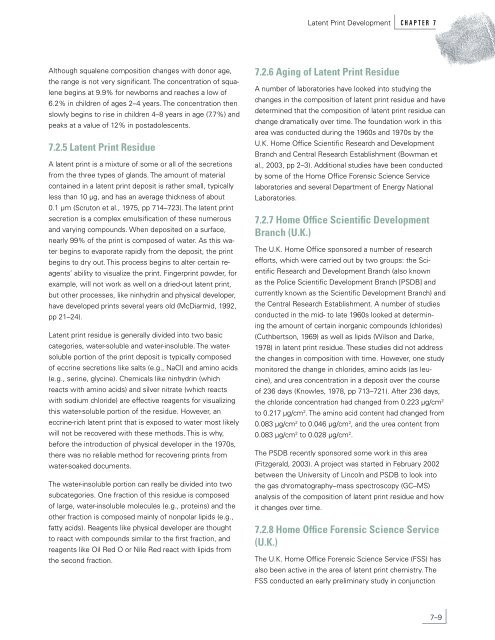Latent Print Development - National Criminal Justice Reference ...
Latent Print Development - National Criminal Justice Reference ...
Latent Print Development - National Criminal Justice Reference ...
You also want an ePaper? Increase the reach of your titles
YUMPU automatically turns print PDFs into web optimized ePapers that Google loves.
Although squalene composition changes with donor age,<br />
the range is not very significant. The concentration of squalene<br />
begins at 9.9% for newborns and reaches a low of<br />
6.2% in children of ages 2–4 years. The concentration then<br />
slowly begins to rise in children 4–8 years in age (7.7%) and<br />
peaks at a value of 12% in postadolescents.<br />
7.2.5 <strong>Latent</strong> <strong>Print</strong> Residue<br />
A latent print is a mixture of some or all of the secretions<br />
from the three types of glands. The amount of material<br />
contained in a latent print deposit is rather small, typically<br />
less than 10 μg, and has an average thickness of about<br />
0.1 μm (Scruton et al., 1975, pp 714–723). The latent print<br />
secretion is a complex emulsification of these numerous<br />
and varying compounds. When deposited on a surface,<br />
nearly 99% of the print is composed of water. As this water<br />
begins to evaporate rapidly from the deposit, the print<br />
begins to dry out. This process begins to alter certain reagents’<br />
ability to visualize the print. Fingerprint powder, for<br />
example, will not work as well on a dried-out latent print,<br />
but other processes, like ninhydrin and physical developer,<br />
have developed prints several years old (McDiarmid, 1992,<br />
pp 21–24).<br />
<strong>Latent</strong> print residue is generally divided into two basic<br />
categories, water-soluble and water-insoluble. The watersoluble<br />
portion of the print deposit is typically composed<br />
of eccrine secretions like salts (e.g., NaCl) and amino acids<br />
(e.g., serine, glycine). Chemicals like ninhydrin (which<br />
reacts with amino acids) and silver nitrate (which reacts<br />
with sodium chloride) are effective reagents for visualizing<br />
this water-soluble portion of the residue. However, an<br />
eccrine-rich latent print that is exposed to water most likely<br />
will not be recovered with these methods. This is why,<br />
before the introduction of physical developer in the 1970s,<br />
there was no reliable method for recovering prints from<br />
water-soaked documents.<br />
The water-insoluble portion can really be divided into two<br />
subcategories. One fraction of this residue is composed<br />
of large, water-insoluble molecules (e.g., proteins) and the<br />
other fraction is composed mainly of nonpolar lipids (e.g.,<br />
fatty acids). Reagents like physical developer are thought<br />
to react with compounds similar to the first fraction, and<br />
reagents like Oil Red O or Nile Red react with lipids from<br />
the second fraction.<br />
<strong>Latent</strong> <strong>Print</strong> <strong>Development</strong> C H A P T E R 7<br />
7.2.6 Aging of <strong>Latent</strong> <strong>Print</strong> Residue<br />
A number of laboratories have looked into studying the<br />
changes in the composition of latent print residue and have<br />
determined that the composition of latent print residue can<br />
change dramatically over time. The foundation work in this<br />
area was conducted during the 1960s and 1970s by the<br />
U.K. Home Office Scientific Research and <strong>Development</strong><br />
Branch and Central Research Establishment (Bowman et<br />
al., 2003, pp 2–3). Additional studies have been conducted<br />
by some of the Home Office Forensic Science Service<br />
laboratories and several Department of Energy <strong>National</strong><br />
Laboratories.<br />
7.2.7 Home Office Scientific <strong>Development</strong><br />
Branch (U.K.)<br />
The U.K. Home Office sponsored a number of research<br />
efforts, which were carried out by two groups: the Scientific<br />
Research and <strong>Development</strong> Branch (also known<br />
as the Police Scientific <strong>Development</strong> Branch [PSDB] and<br />
currently known as the Scientific <strong>Development</strong> Branch) and<br />
the Central Research Establishment. A number of studies<br />
conducted in the mid- to late 1960s looked at determining<br />
the amount of certain inorganic compounds (chlorides)<br />
(Cuthbertson, 1969) as well as lipids (Wilson and Darke,<br />
1978) in latent print residue. These studies did not address<br />
the changes in composition with time. However, one study<br />
monitored the change in chlorides, amino acids (as leucine),<br />
and urea concentration in a deposit over the course<br />
of 236 days (Knowles, 1978, pp 713–721). After 236 days,<br />
the chloride concentration had changed from 0.223 μg/cm2 to 0.217 μg/cm2 . The amino acid content had changed from<br />
0.083 μg/cm2 to 0.046 μg/cm2 , and the urea content from<br />
0.083 μg/cm2 to 0.028 μg/cm2 .<br />
The PSDB recently sponsored some work in this area<br />
(Fitzgerald, 2003). A project was started in February 2002<br />
between the University of Lincoln and PSDB to look into<br />
the gas chromatography–mass spectroscopy (GC–MS)<br />
analysis of the composition of latent print residue and how<br />
it changes over time.<br />
7.2.8 Home Office Forensic Science Service<br />
(U.K.)<br />
The U.K. Home Office Forensic Science Service (FSS) has<br />
also been active in the area of latent print chemistry. The<br />
FSS conducted an early preliminary study in conjunction<br />
7–9

















